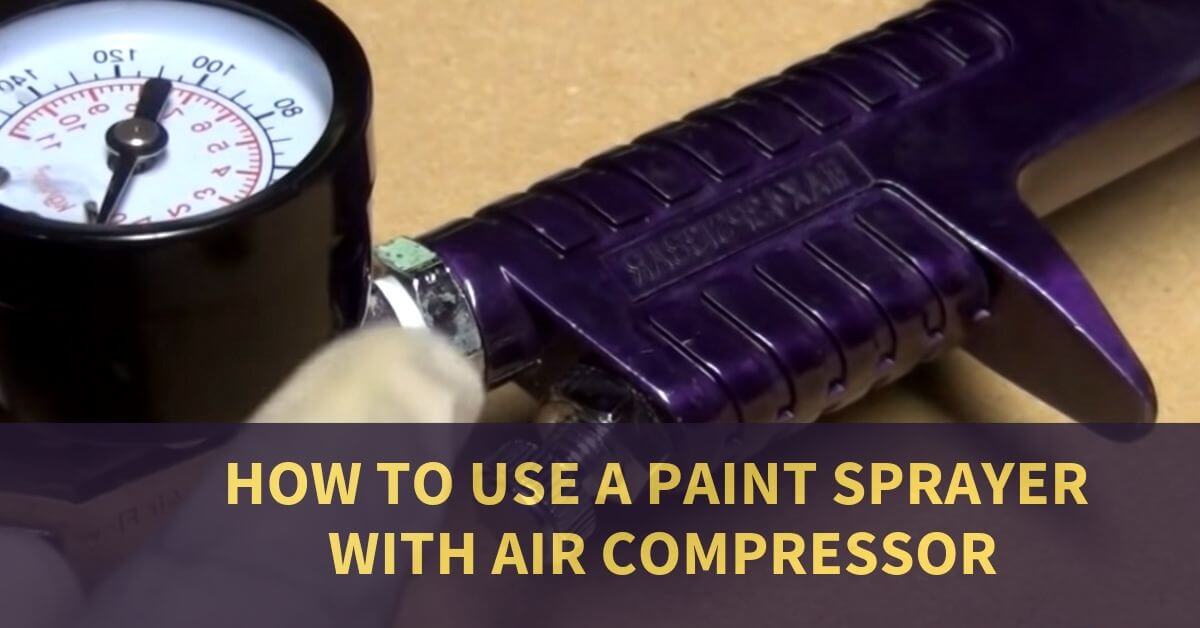For painting projects, rollers and brushes may seem like easy, safe choices but paint sprayers are an even better choice for their practical use. You will be able to finish a painting in half time with more smooth, even coating with a professional looking result. In this case, paint sprayer with air compressor comes in handy. It effectively saves your money and time while at the same time bypassing the pollution that is generally brought about by aerosol propellants.
Sprayers with air compressor models are the most popular among the professional painters and hobbyists alike. Even though attaching an air compressor to a paint sprayer can sound tricky and complex, it is not that difficult to maneuver. With proper guidelines and understanding, anyone can easily and comfortably be able to use air compressed sprayers. Hopefully, this article will help you understand the basic workings of air compressor and how to use a sprayer with air compressor.
Why You Need an Air Compressor with a Paint Sprayer ?
An air compressor provides the necessary pressure needed for the painting. The air compressor helps the paint sprayer with the right pressure to release the precise paint flow effectively. To achieve the right pressure for the paint flow, sprayers are equipped with certain pressure generation tools and minimizes any paint wastage. The volume of air used in a sprayer is significantly lower than that used in airless paint sprayers. That means the models using an air compressor will cost slightly lower than the airless models. Apart from its low cost energy saving benefits, the sprayer with air compressor delivers fine quality and smooth finishes for your painting projects. It also ensures easy and even application of paint during spraying. Thus, you can achieve professional level results without having to hire an expert for the job.
Preparing the Paint Sprayer
To ensure effective use of a paint sprayer with an air compressor, just spraying the surface is not enough. There are some initial preparations needed, such as preparing the sprayer and the air compressors as well. Here follow the steps below for a professional spraying job.
Select the Right Paint and Thinner
Compressed air sprayers are compatible with most paints, but latex, acrylic or oil-based paints are most suitable and heavily used with it. Paint thinning means mixing paint with suitable thinner so that it can flow freely. 15%-20% thinning is good enough for a good flow.
Prepare the Surface Area to Be Painted
Before painting, make sure to clear the surface area and there is enough ventilation. You can use cloths, plastic sheets, painter’s tape, mask or newspaper to cover furniture and floor surfaces. Otherwise, the paint will be spread all over the place due to over spray.
Putt on Protective Gear
Safety precautions should always come first. Wear gloves, masks and safety glasses. If you have an allergy or severe health problems, wear a respirator to avoid inhaling the fumes and paint particles.
Prime the Surface
The painting surface needs to be dry, oil free and rust free and it can be smoothed down by sanding, grinding, and brushing. Adding solution with water, wash the surface thoroughly to remove any dirt, oil and dust. After drying, apply a layer of primer over the surface to get a good finish after spraying the paint.
Prepare the Air Compressor
Once you are ready to paint, turn on the air compressor, adjust the regulator between 12 and 25 PSI (pounds per square inch) and attach the air hose. Examine the compression chamber to make sure that the pressure is set at the correct level. Practice some painting techniques and sweeping motion to get a feel of the balance and weight.
Pour a Small Amount of Paint Thinner
Normally, there’s a reservoir in the sprayer for adding the thinner which is placed at the bottom. Fill the cup with the paint you have already thinned and attach it securely to the sprayer.
Prime the Sprayer
After attaching, squeeze the primer to check whether the paint comes out of the nozzle or not. At first, air will come out for a couple minutes then, it will spray paint. If there’s a problem with the flow of the thinner, then check the spray for leakage and fix it accordingly.
Painting
Using a paint sprayer with air compressor is a pretty simple process. With everything already properly attached, the air compressor and the sprayer will do the job for you. Hold the spray gun at least 8-10 inches away from the surface you are painting and maintain a fluid up and down, back and forth sweeping motion. Keep the sprayer moving continuously, spraying the paint in straight, smooth strokes to avoid drips and runs. Continue until you finish painting the whole surface.
Tips
- Wear protective gear while spraying
- Practice spraying water on paper to avoid unexpected situations
- Spray either vertically or horizontally, but not both on the same project
- Start the sprayer in motion before pulling the trigger to avoid thick spots on the painting surface
- Release the trigger before stopping the motion of the sprayer
- Mix your paint well before using to avoid clogging
- Use sprayer with air compressor for painting large, multiple surfaces painting fast
- Always read the user’s manual carefully and follow the instructions
Conclusion
An air compressor is a necessity for efficient use of a paint sprayer. It helps in generating the exact amount of pressure that is required by your device. By doing this, not only it eliminates wastage but also conserves energy. One of the key benefits is that it regularly delivers finer quality and even finishes for your painted surface. The best sprayer for painting will improve your productivity and guarantee perfect work for both small scale and large scale projects. Here, along with the benefits of air compressors to sprayers for painting, the process of using a sprayer with an air compressor has been elaborated.
No matter how difficult it seems, actually using a sprayer with air compressor is a pretty easy job. With time and practice, you can certainly become a pro in no time. Just have confidence and faith in yourself. Happy painting!
Related Posts:

